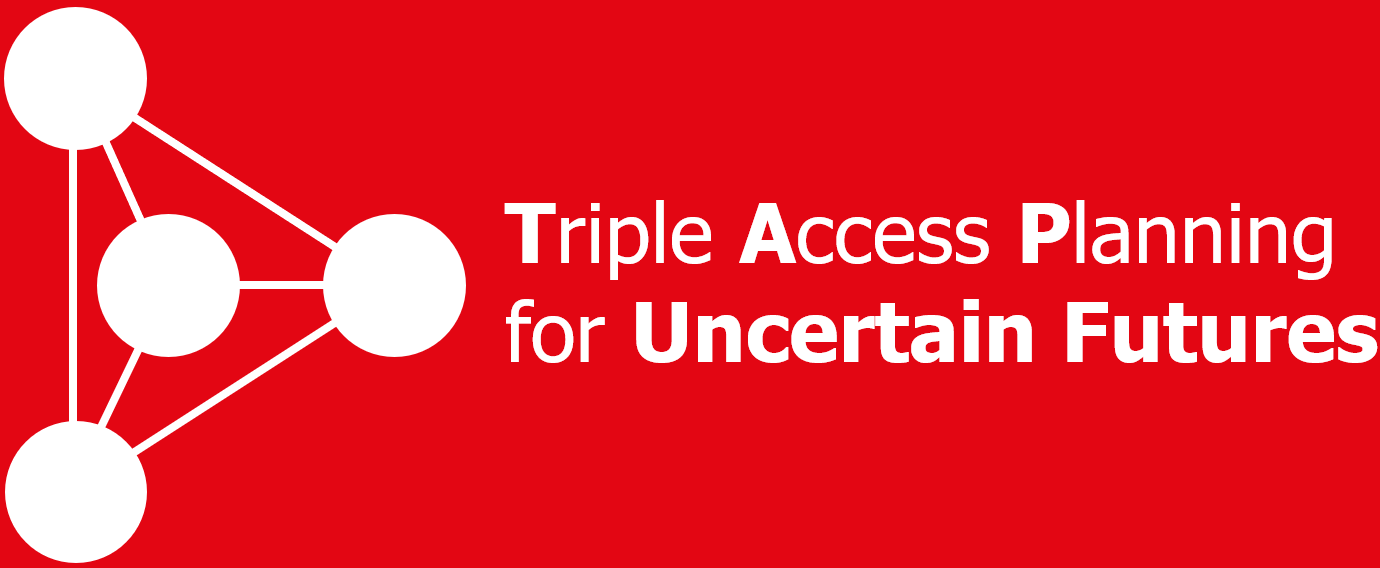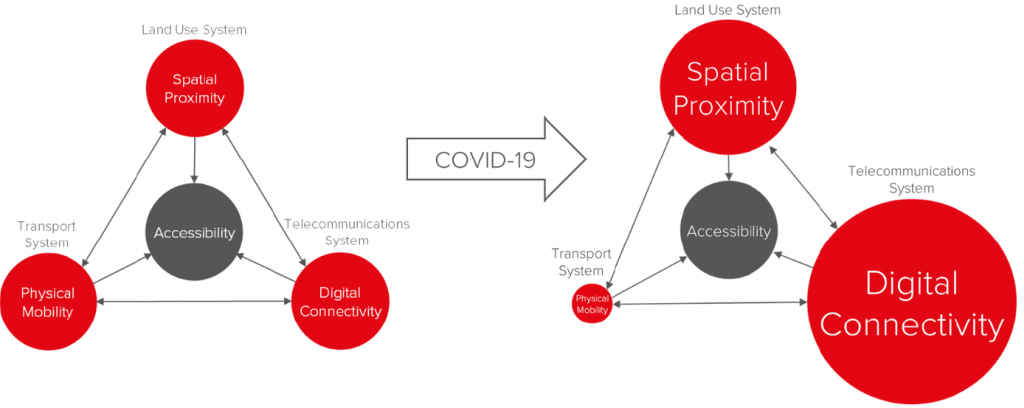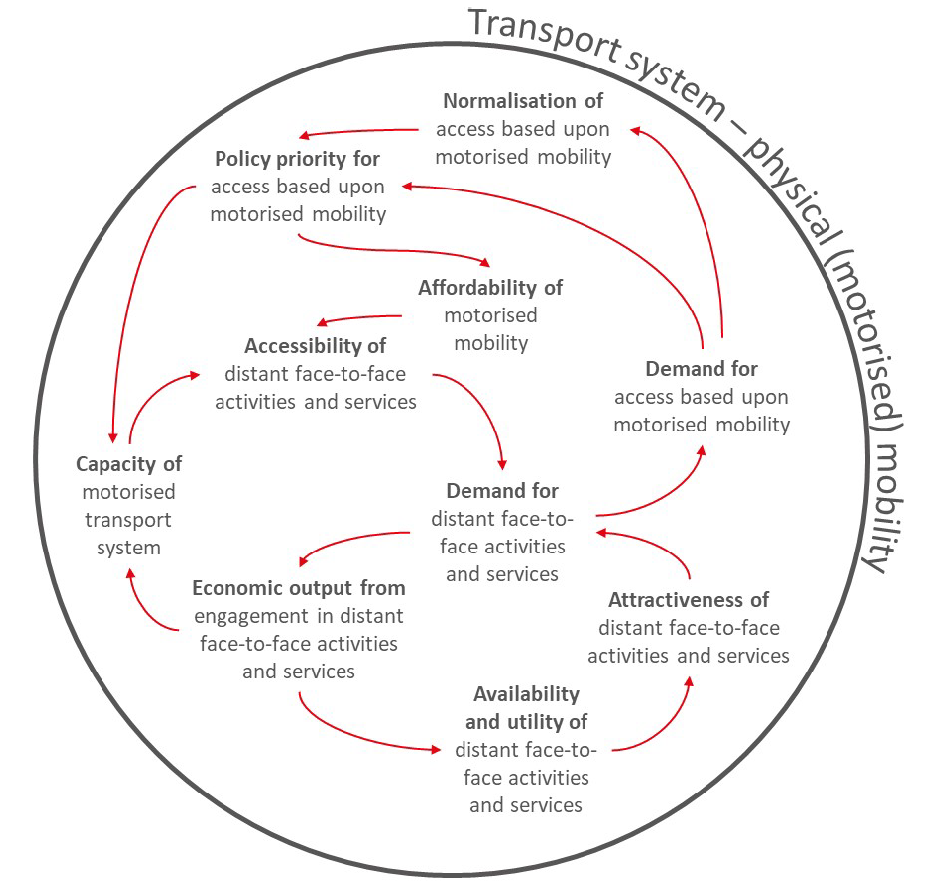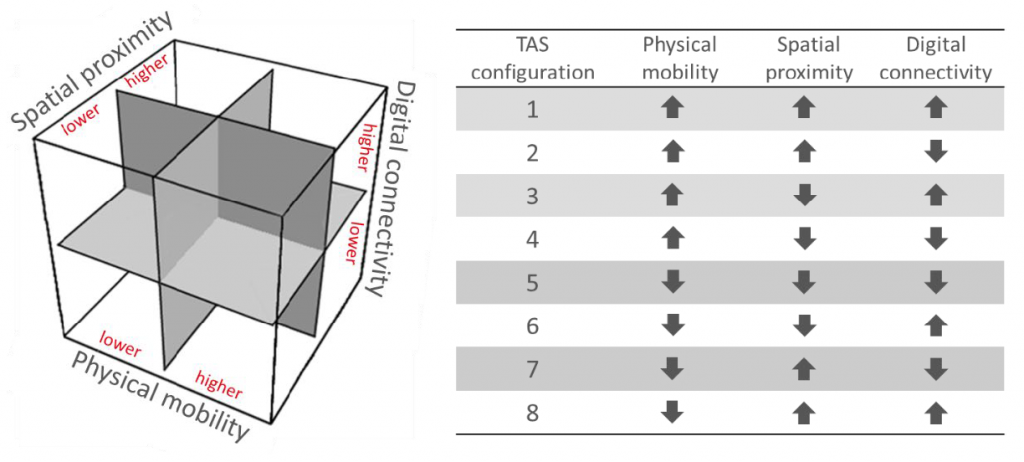
The term ‘Triple Access Planning’ (TAP) seems to be gaining traction. Triple access is about recognising, understanding and shaping the world in which we live – a world in which there are three means to access people, goods, jobs, services and opportunities: physical mobility (transport system), spatial proximity (land use system) and digital connectivity (telecommunications system). The Triple Access System requires us to lift our heads up from a rather myopic focus on transport solutions to transport problems in transport planning. This is something the pan-European project ‘Triple Access Planning for Uncertain Futures’ aims to help with. It comes at a time when the world is grappling with the COVID-19 pandemic, the climate emergency and uncertainty about the future.
The project began in May 2021 and has academic, public authority and consultancy partners in Italy, the Netherlands, Slovenia, Sweden and the UK. In December 2021 the UK academic and non-academic partners came together to reflect upon the project. This short article summarises some of the points that came to light in their conversation:

Time to think – As a policymaker and as a planner, systems thinking is about being able to stand back and make sense of the system that one is hoping to shape and improve. It can be all too easy to see the time to think in a busy world squeezed out. Facing the immediacy and urgency of the COVID-19 pandemic and climate emergency respectively suggests even less time to think, with a need to see action. Yet ironically, thinking is needed more than ever. We need to reflect upon, challenge and develop our mental models of the system of mobility in the wider context of examining the Triple Access System. The TAP for Uncertain Futures project is allowing us to do this. It is providing time to think. After all – failing to think and then plan, is planning to fail…

Drawing upon experience – A common challenge when we are asked to contemplate future development is that we haven’t experienced it so how can we offer a meaningful view? The COVID-19 pandemic has given us all some experience in the present of what could be a more mainstream future – we have seen how it is possible to make very different use of the Triple Access System (affecting where, when and how we do things – notably with higher collective reliance on digital connectivity for work, shopping and leisure), and found it in some respects rather appealing (while in respects less so in terms, for example, of social isolation). The exposure from this shared experience creates an important platform for thinking differently about the future and how we plan for it. The project has arrived at an opportune time.

Giving credence to TAP – As a three-year project dedicated to Triple Access Planning, TAP for Uncertain Futures helps to bring the concept to life and to give it legitimacy and visibility. It forms part of a ‘learning by talking about it and doing it’ culture. Several organisations inside and outside of the project consortium are now referring to Triple Access Planning and using it to frame their thinking and planning (from small acorns…..). The project and its website offer a boost for innovators and early adopters to bring Triple Access Planning to the attention of their colleagues and stakeholders. The project also provides an important forum for learning how to better articulate what is a more challenging representation of the world than perhaps we have seen previously in transport planning – it’s not as simple as ‘if you push a button here, something happens over there’.

Beyond silos and boundaries – It’s not easy doing joined up thinking. The hope of better integration between land use and transport goes back to the 1960s. Accessibility planning was something that brought ‘access’ to the fore in the 2000s but joined up thinking and action hasn’t proved to be easy, or easy to sustain. In a resource-constrained planning environment “it’s not my department, it’s not my problem” can soon trip off the tongue. Yet siloed thinking and action in a Triple Access System risk becoming more vulnerable to unanticipated consequences and missed opportunities if we do not broaden our field of view and collective action.

Climate change makes it our problem – Yet perhaps COVID-19 and the climate emergency make the need for joined up thinking and action greater than it’s ever been – we all have a problem and need to be more open-minded and co-operative if we are to make the progress that is needed. The challenge – one that the project will need to grapple with – is how to make a more complex ‘system of systems’ proposition accessible and persuasive to those in authority in different functional parts of the public sector. The proposition has to ring out ‘this can help you to overcome the problems you face and the opportunities that you may have for the taking’.

A TAP castle on sand – The TAP for Uncertain Futures project is embarking on a review of existing Sustainable Urban Mobility Plans (SUMPs) and equivalent documents across 40-50 urban areas in several European countries. This will help to understand the extent to which existing guidance on urban mobility planning is being put into practice. What will it discover? The hope would be that strong planning is found in many locations, suggesting a firm bedrock upon which to build Triple Access Planning. Yet suppose the aspired for Triple Access Planning ‘castle’ is being built upon sand? What if existing urban mobility planning is still struggling in some respects with more fundamental issues of understanding, resources and agency when it comes to supporting policymaking to shape the future? This remains to be seen and will be an important contribution from the project.

Rethinking analytical robustness – The biggest risk facing urban planning authorities may be being risk averse. In the face of the discomfort of a changing and uncertain world it may be tempting to seek solace in the familiar. The orthodox transport planning approach may prevail, involving tried and tested measures and perhaps strongly guided by being forecast-led instead of vision-led. This may perpetuate a reliance on a particular understanding of analytical robustness where being precisely wrong can be favoured over being approximately right. Consider the prospect of investing to transform digital connectivity to reshape the Triple Access System, or closing a city centre to traffic to provide priority for active travel and proximate encounters. Such bold changes may seem hard to contemplate and to justify, even if triple access thinking may instinctively suggest they are meritorious. COVID-19 gave us many glimpses of how swift and rather transformative actions – light on analytical underpinnings – can be taken to change the system, changes to which humans respond and adapt. Whether or not adaptation is universally well-received is another matter and lessons are being learned in this regard.

A public coming on side – We live in a world that has historically been driven by pursuit of economic prosperity and within which cost and convenience have been important determinants of behaviour. It has been a challenging environment within which to suggest ambitions for less travel and less motorised travel, and to realise such ambitions. Yet now the imperative of addressing climate change is with all urban authorities, with many having declared a climate emergency. The imperative has also seemingly been growing in the minds of the electorate. In Britain the latest November Ipsos MORI Issues Index indicates concern about the environment and climate change are at the highest level since this tracker survey began in the 1980s. Concern for the environment and climate change is considerably higher than for the economy. People will doubtless still weigh cost and convenience heavily in the choices they make but they may be more tolerant of urban mobility planning interventions that are designed to reshape the Triple Access System and the choices within it.

Window of opportunity – None of this is easy as is well-recognised by the project partners themselves. However, the difficult position the world finds itself in will not be eased by strategic ignorance and a temptation to muddle along doing what was always done. Substantial change needs to happen. The pain of change can perhaps be eased by redistributing how we fulfil our access needs and desires within the Triple Access System. The project finds itself in the midst of an unprecedented opportunity. COVID-19 has illuminated the resilience offered by the Triple Access System and the adaptability of humans within the system, when system conditions change. The increasing emphasis on goals for the future in terms of emissions reduction and changes to technology and behaviour suggests a growing move from being forecast-led to vision-led in planning. The climate emergency brings us together in what can be a united effort to achieve substantial but also inclusive change. Triple Access Planning may in these circumstances help provide the key to unlocking new opportunities for society to respond positively and effectively to the circumstances it faces. Perhaps then, TAP for Uncertain Futures is in the right place at the right time.
__
Glenn Lyons is the Mott MacDonald professor of future mobility at UWE Bristol, and the coordinator for the project Triple Access Planning for Uncertain Futures.



